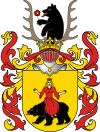Julian Ursyn Niemcewicz facts for kids
Quick facts for kids
Julian Ursyn Niemcewicz
|
|
|---|---|
 Portrait by Antoni Brodowski  |
|
| Born | 6 February 1758 |
| Died | 21 May 1841 (aged 83) |
| Nationality | Polish |
| Education | Warsaw Corps of Cadets |
| Occupation | Poet, playwright, statesman |
| Spouse(s) |
Susan Livingston Kean
(m. 1800; |
Julian Ursyn Niemcewicz (born February 6, 1758 – died May 21, 1841) was an important Polish poet, writer, and statesman. A statesman is someone who is good at leading a country. He strongly supported the Constitution of 3 May 1791 for the Polish–Lithuanian Commonwealth.
Contents
Early Life and Education
Julian Ursyn Niemcewicz was born on February 6, 1758. He grew up in Skoki, a town near Brest, Belarus. At that time, this area was part of the Polish–Lithuanian Commonwealth. His family was Polish nobility, meaning they were from a respected, well-off family. Julian went to the Warsaw Corps of Cadets. This was a special military school where young people learned to be officers.
His Career and Travels
After finishing his studies, Julian Ursyn Niemcewicz worked as an assistant to Adam Kazimierz Czartoryski. He traveled a lot, visiting countries like France, England, and Italy.
Niemcewicz became a representative in the Great Sejm (a type of parliament) from 1788 to 1792. He was a very active member of the Patriotic Party. This group helped pass the important Constitution of 3 May 1791. He also helped start the Friends of the Constitution group. This group worked to make sure the new constitution was put into action.
However, in 1792, a group called the Targowica Confederation won. They overturned the May 3 Constitution. Because of this, Niemcewicz and other Patriotic Party members had to leave Poland. They moved to Germany.
Time in America
During the Kościuszko Uprising in 1794, Niemcewicz was an assistant to Tadeusz Kościuszko. Kościuszko was a famous Polish general. Both of them were captured by the Russians in a battle and put in prison.
In 1796, a new ruler, Tsar Paul I, released them. Niemcewicz and Kościuszko then traveled together to the United States. They arrived in Philadelphia on August 18, 1797. While in America, Niemcewicz visited famous places like Niagara Falls. In 1798, he became a member of the American Philosophical Society.
Niemcewicz was surprised when Kościuszko left for Europe without telling him.
Return to Poland and Exile
After Napoleon invaded Poland in 1807, Niemcewicz went back to Warsaw. He became the secretary of the senate, which is a part of the government. After the Congress of Vienna, he was the secretary of state in Poland. He also led the committee that worked on the country's constitution.
During the time of the Kingdom of Poland, Niemcewicz was a very important person in Polish culture. His influence was so strong that some compared it to the political power of Grand Duke Constantine.
On May 11, 1830, he helped reveal a new statue in Warsaw. It was a monument to Nicolaus Copernicus, a famous astronomer. The statue was made by Bertel Thorvaldsen.
During the November Uprising (1830–31), Niemcewicz was part of the Polish government that fought for independence. In the last months of the uprising, he went to London as a diplomat. He stayed in exile, first in Britain and then in France, until he died in 1841.
His Writings
Julian Ursyn Niemcewicz wrote in many different styles. His play, The Return of the Deputy (1790), was very popular. He also wrote a novel called John of Tenczyn (1825). This book was like the adventure novels of Sir Walter Scott. It showed a lively picture of old Poland.
He also wrote a history book called History of the Reign of Sigismund III (1819). He collected his memories of ancient Polish history into six volumes (1822–23). His complete works were published in 47 books between 1838 and 1840.
Personal Life
While he was in the United States, Niemcewicz met a wealthy widow named Mrs. Livingston Kean. Her first name was Susan Livingston. He had been hired to teach her son, Peter Kean. Julian and Susan got married in 1800. Susan was from the important Livingston family. Her father was Peter Van Brugh Livingston, and she was the widow of John Kean.
Julian Ursyn Niemcewicz died on May 21, 1841, in Paris, France. He was 83 years old. He was buried at Champeaux Cemetery in Montmorency, Val-d'Oise.
Published Works
- Władysław pod Warną (Władysław at Varna, 1788)
- Kazimierz Wielki (Kazimierz the Great, 1792)
- Powrót posła (The Return of the Deputy, 1791)
- Na hersztów targowieckich (The Targowica Chiefs)
- Podróże historyczne po ziemiach polskich (Historic Travels over the Polish Lands)
- Śpiewy historyczne (Historic Songs)
- Dzieje panowania Zygmunta III (A History of the Reign of Zygmunt III)
- Under their Vine and Fig Tree: Travels through America in 1797-1799, 1805 with some further account of life in New Jersey (Edited by Budka)
See also
 In Spanish: Julian Ursyn Niemcewicz para niños
In Spanish: Julian Ursyn Niemcewicz para niños



